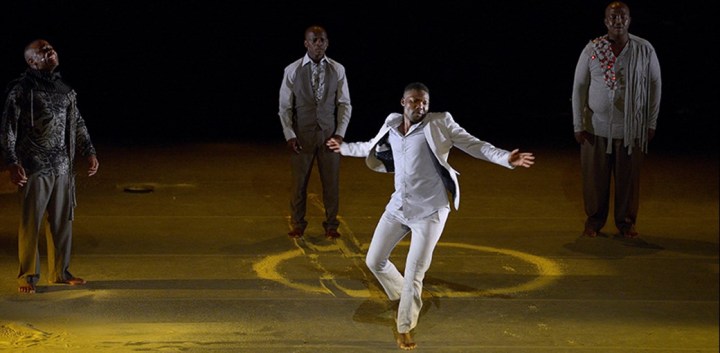Exit/Exist
Review by Cicely Binford
11.2.2017
Gregory Maqoma‘s Exit/Exist is a transcendent beginning to PIAF 2017. The Vuyani Dance Theatre production which tells the story of Chief Maqoma (Gregory Maqoma’s ancestor), an eminent Xhosa chief in South Africa’s frontier wars of the 19th century, is a brilliant work of sound and vision. Maqoma moves within a rich world of sublime music, referencing folk and contemporary dance, and expresses the nobility of a triumphant spirit.
The central figure stands in a dark stage as guitar strings are plucked over a loop. Maqoma’s hands and arms respond with jittery, nervous flickering, and as the plucked strings build, so does the light and Maqoma’s movement. He’s dressed in a shiny suit that hangs loosely over is body, so every twitch creates a ripple across his clothing. A steady beat emerges, and Maqoma makes his way around the space with tapping bare feet, flickering arms, and pulsating shoulders.
We begin to make out a figure on guitar behind a scrim, Giuliano Modarelli, the single man creating a symphony to accompany Maqoma’s dance. Four masked figures proceed from stage right, also behind the scrim, each in different dress, to chime in with Modarelli with luscious four-part harmonies that send a shiver up the arms. They become players in Maqoma’s story, but more importantly, they are the architects of the enveloping sonic world of Exit/Exist.
They are the Vuyani Ensemble, comprised of Xolisile Bongawana, Anele Ndebele, Sizwe Samuel Nhalpo, and Siphiwe Nkabinde. Rhythmic, dynamic, soaring, velvet vocals create a cathedral that we can’t see, but can feel. They even breathe in chorus and never miss a beat, and come around from behind the scrim to sings and sometimes move with Maqoma, sometimes bringing props and costume pieces, but always integrated within the narrative.
With regards to the narrative for an Australian audience, there is almost no English in the piece, and not a surtitle in sight. The only springboard for what we see is a simple prologue in English projected onto the scrim at the show’s opening and what Maqomba offers in the notes of the program. The work is performed in the Xhosa language, but this presents no barrier. Maqoma’s story is understood; movement and music are languages that override linguistic barriers.
I waited the whole time for Maqoma to burst forth across the stage with the full power that he clearly possesses for more than just the few seconds he occasionally does so. But this is not the story Maqoma is trying to tell. This dance is largely contained, compacted in the quivering of his extremities, his hands and ever-tapping, stamping feet. He blends in some contemporary style, and even gives a nod to Michael Jackson, but much of the movement seems to lie in traditional dances.
We get a sense of how some of the events of Chief Maqoma’s life played out with the aid of more theatrical moments, visual projections (Mileta Postic), and lighting states (Ralf Nonn). Exit/Exist is a rousing work that brings the audience to their feet for a well-deserved ovation.
If you won’t get a chance to see Exit/Exist, I highly recommend you try to catch the Vuyani Ensemble at St George’s Cathedral on Feb 16 which is sure to be an unforgettable and moving experience.
For tickets and more information on both shows, visit the PIAF website here.

